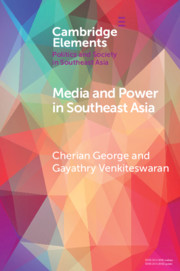Element contents
Media and Power in Southeast Asia
Published online by Cambridge University Press: 12 August 2019
Summary
- Type
- Element
- Information
- Online ISBN: 9781108665643Publisher: Cambridge University PressPrint publication: 29 August 2019
Bibliography
- 29
- Cited by



